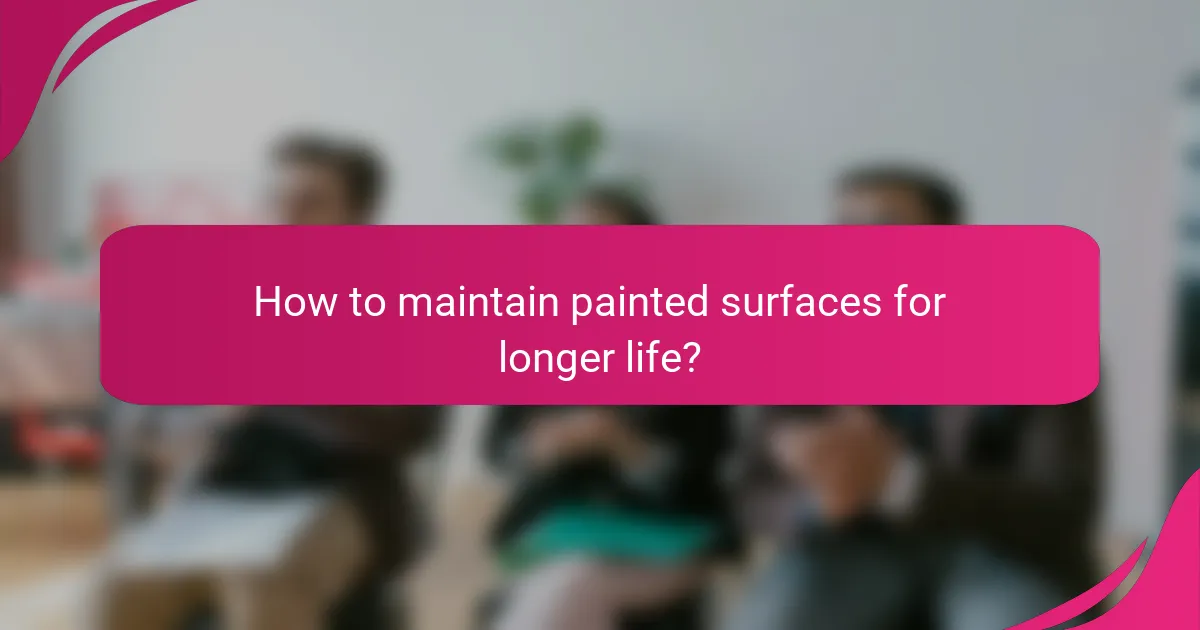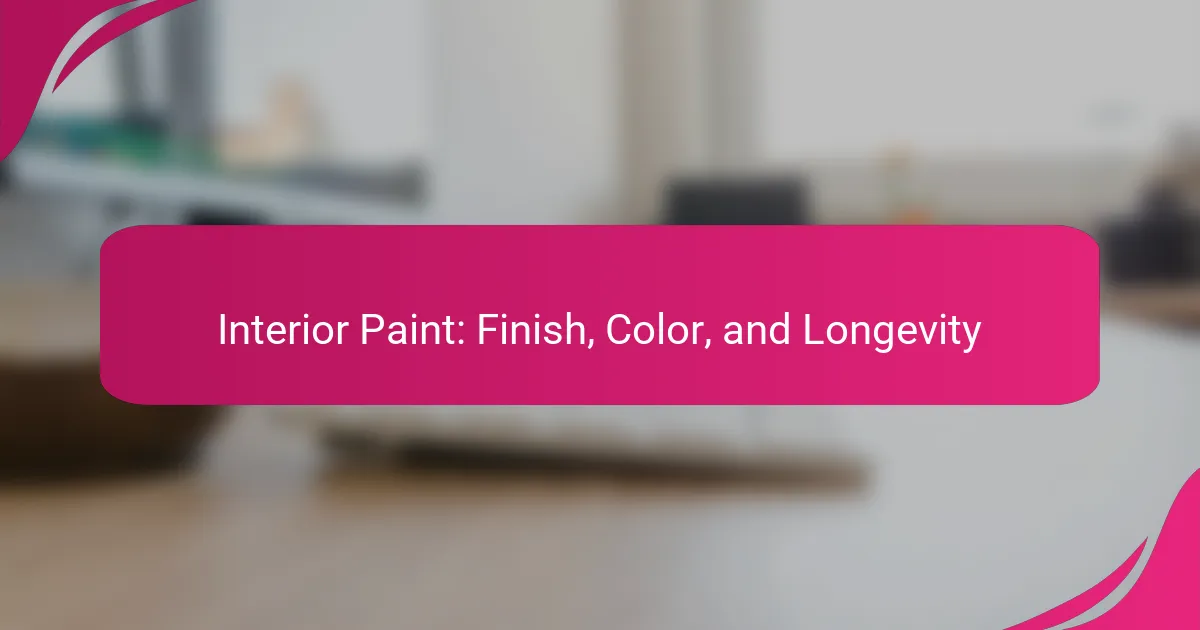When selecting interior paint, it’s essential to consider the finish, color, and longevity to achieve the desired aesthetic and durability. Different finishes, such as satin and gloss, offer varying levels of sheen and resilience, making them suitable for specific areas of your home. Additionally, the right color choice can significantly impact the ambiance of a space, while understanding the lifespan of different paint types ensures your investment lasts for years to come.

What are the best interior paint finishes for durability?
The best interior paint finishes for durability include satin, eggshell, matte, gloss, and semigloss. Each finish offers different levels of sheen and resilience, making them suitable for various applications and environments within the home.
Satin finish
Satin finish is known for its soft sheen and durability, making it a popular choice for high-traffic areas like hallways and living rooms. It is easy to clean, which helps maintain its appearance over time.
This finish strikes a balance between gloss and matte, providing a subtle shine without being overly reflective. It is ideal for walls that require some washability but still want a warm, inviting look.
Eggshell finish
Eggshell finish has a low sheen that resembles the surface of an eggshell, offering a slightly more durable option than matte finishes. It is suitable for areas like bedrooms and dining rooms, where a softer look is desired.
This finish is relatively easy to clean and can hide minor imperfections on walls, making it a practical choice for residential interiors. It provides a good balance of aesthetics and functionality.
Matte finish
Matte finish is characterized by its non-reflective surface, which can create a sophisticated and elegant look. However, it is less durable and more challenging to clean compared to other finishes.
This type is best used in low-traffic areas, such as ceilings or accent walls, where durability is less of a concern. It can effectively hide imperfections but may require more frequent touch-ups.
Gloss finish
Gloss finish offers a high sheen and exceptional durability, making it ideal for surfaces that experience wear and tear, such as trim, cabinets, and doors. It is highly washable and resistant to stains.
This finish can reflect light, which can enhance the brightness of a room, but it may also highlight imperfections in the surface. Proper surface preparation is essential for achieving the best results with gloss paint.
Semigloss finish
Semigloss finish provides a moderate sheen that combines the benefits of both gloss and satin finishes. It is durable and easy to clean, making it suitable for kitchens, bathrooms, and other areas prone to moisture.
This finish is often used on moldings and trim, as it offers a polished look while still being practical. It strikes a good balance between aesthetics and functionality, making it a versatile choice for various applications.

How to choose the right paint color for your home?
Choosing the right paint color for your home involves considering various factors such as room size, lighting, and personal preferences. A well-selected color can enhance the mood of a space and create a cohesive look throughout your home.
Consider room size
The size of a room significantly influences how colors appear. Lighter shades can make small spaces feel larger and more open, while darker colors can create a cozy atmosphere in larger rooms. For instance, soft pastels or whites are ideal for compact areas, whereas deeper hues work well in expansive living rooms.
As a general rule, if a room is less than 100 square feet, opt for lighter colors. For larger spaces, you can experiment with bolder shades to add depth and character.
Assess lighting conditions
Lighting plays a crucial role in how paint colors are perceived. Natural light can enhance colors, making them appear brighter, while artificial lighting can alter their appearance, sometimes making them look warmer or cooler. Always test paint samples in the actual lighting conditions of the room.
Consider the direction of the light source; north-facing rooms tend to have cooler light, while south-facing rooms receive warmer light. This can affect your choice, so observe how the color changes throughout the day.
Understand color psychology
Color psychology is the study of how colors affect emotions and behaviors. For example, blues and greens are often calming and promote relaxation, making them suitable for bedrooms and bathrooms. In contrast, yellows and oranges can energize a space, making them ideal for kitchens or playrooms.
Think about the mood you want to create in each room. Using color strategically can enhance the functionality of the space and influence how you feel in it.
Explore trending color palettes
Staying updated on trending color palettes can inspire your choices and ensure your home feels modern. Popular palettes often include combinations of neutral tones with bold accent colors, creating a balanced and inviting environment.
For 2023, consider shades like soft terracotta, muted greens, and rich navy. These colors can be paired with whites or grays to create a harmonious look. Use online resources or paint swatches to visualize how these trends can work in your home.

What is the longevity of different interior paints?
The longevity of interior paints varies significantly based on the type of paint used. Generally, latex paints last around 5 to 10 years, oil-based paints can endure for 10 to 15 years, and chalk paints typically have a lifespan of 3 to 7 years, depending on the application and environment.
Latex paint lifespan
Latex paint, known for its water-based formulation, usually lasts between 5 to 10 years. Its durability is influenced by factors such as surface preparation, application method, and environmental conditions like humidity and temperature.
To maximize the lifespan of latex paint, ensure proper surface cleaning and priming before application. Avoiding high moisture areas can also help maintain its appearance and longevity.
Oil-based paint lifespan
Oil-based paint typically has a longer lifespan, ranging from 10 to 15 years. This type of paint is more resistant to wear and tear, making it suitable for high-traffic areas or surfaces that require extra durability.
However, oil-based paints take longer to dry and require solvents for cleanup. When using oil-based paint, consider its strong odor and ensure adequate ventilation during application.
Chalk paint lifespan
Chalk paint generally lasts around 3 to 7 years, depending on the surface and usage. While it provides a unique matte finish and is easy to distress, it is less durable compared to latex and oil-based paints.
To extend the life of chalk paint, apply a protective topcoat, especially in areas prone to scuffs or stains. Regular maintenance, such as cleaning with a damp cloth, can also help preserve its finish.

What factors affect paint longevity in homes?
Several factors significantly influence the longevity of paint in homes, including environmental conditions, surface preparation, and application techniques. Understanding these elements can help homeowners select the right products and methods to extend the life of their paint jobs.
Environmental conditions
Environmental conditions play a crucial role in the durability of paint. Factors such as humidity, temperature fluctuations, and exposure to sunlight can cause paint to deteriorate more quickly. For instance, high humidity can lead to mold growth, while extreme temperatures can cause paint to crack or peel.
To improve paint longevity, consider the climate of your area. In regions with high UV exposure, using paint with UV protection can help maintain color and finish. Additionally, applying paint during moderate temperatures can enhance adhesion and drying times.
Surface preparation
Proper surface preparation is essential for achieving a long-lasting paint finish. This includes cleaning, sanding, and priming surfaces before application. Neglecting these steps can result in poor adhesion, leading to premature peeling or chipping.
For best results, ensure surfaces are clean and dry, and repair any imperfections. Using a primer suited for the surface type can create a better bond and improve the overall durability of the paint.
Application techniques
Application techniques significantly impact the performance and longevity of paint. Techniques such as brushing, rolling, or spraying can affect the thickness and uniformity of the paint layer. Applying too thin a coat may not provide adequate coverage, while too thick a coat can lead to cracking.
To optimize application, follow the manufacturer’s guidelines for drying times between coats and use the appropriate tools for the job. For example, using a high-quality brush or roller can ensure even coverage and a smoother finish, contributing to a longer-lasting result.

How to maintain painted surfaces for longer life?
To maintain painted surfaces for longer life, regular care and attention are essential. Simple practices like cleaning, touch-ups, and controlling humidity can significantly extend the lifespan of your paint job.
Regular cleaning
Regular cleaning is crucial for preserving the appearance and integrity of painted surfaces. Dust, dirt, and grime can accumulate, dulling the finish and potentially causing damage over time.
Use a soft cloth or sponge with a mild detergent solution to gently clean walls and trim. Aim to clean high-traffic areas every few months, while less-used spaces can be cleaned every six months to a year.
Touch-up painting
Touch-up painting is an effective way to address minor scratches or chips that can occur over time. Keeping a small amount of leftover paint from the original job allows for quick repairs when needed.
Inspect painted surfaces regularly and apply touch-up paint as soon as you notice imperfections. This proactive approach can prevent further damage and maintain the overall look of your walls.
Humidity control
Humidity control plays a vital role in the longevity of painted surfaces. High humidity can lead to mold growth and peeling paint, while excessively dry conditions can cause cracking.
Maintain indoor humidity levels between 30% and 50% using dehumidifiers or humidifiers as needed. Proper ventilation in areas like kitchens and bathrooms also helps prevent moisture buildup, protecting your paint job.
